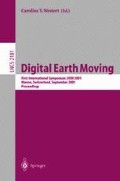Abstract
Elevation data is vital to successful mission planning, operations and readiness. Traditional methods for producing elevation data are very expensive and time consuming; major cloud belts would never be completed with existing methods. The Shuttle Radar Topography Mission (SRTM) was selected in 1995 as the best means of supplying nearly global, accurate elevation data. The SRTM is an interferometric SAR system that flew during 11–22 February 2000 aboard NASA’s Space Shuttle Endeavour and collected highly specialized data that will allow the generation of Digital Terrain Elevation Data Level 2(DTED ® 2). The result of the SRTM will increase the United States Government’s coverage of vital and detailed DTED® 2from less than 5% to 80% of the Earth’s landmass. This paper describes the shuttle mission and its deliverables.
Access this chapter
Tax calculation will be finalised at checkout
Purchases are for personal use only
Preview
Unable to display preview. Download preview PDF.
References
J.C. Curlander and R.N. McDonough, Synthetic Aperture Radar Systems and Signal Processing, John Wiley and Sons, New York, 1991.
F.M. Henderson and A.J. Lewis, Editors, Principles & Applications of Imaging Radar, Manual of Remote Sensing, Third Edition, Volume 2, Published in cooperation with the American Society for Photogrammetry and Remote Sensing, John Wiley and Sons, New York, 1998.
T.H. Dixon, Editor, SAR Interferometry and Surface Change Detection, University of Miami Rosenstiel School of Marine and Atmospheric Science Technical Report TR 95-003, July 1995.
F. Li and R.M. Goldstein, “Studies of multibaseline spaceborne Interferometric Aperture Radars”, IEEE Trans. Geosci. Remote Sensing, 28, pp 88–97, 1990.
W.J. Senus, “Global Mapping Shuttle Radar Topography Mission (SRTM)”, 4th Global Spatial Data Infrastructure Conference, Cape Town, South Africa, March 2000
T.G. Farr and M. Kobrick, “Mapping the World in 3-D: The Shuttle Radar Topography Mission”, Pecoral4 Landsatellite Information III, Denver, Co, December 1999.
Author information
Authors and Affiliations
Editor information
Editors and Affiliations
Rights and permissions
Copyright information
© 2001 Springer-Verlag Berlin Heidelberg
About this paper
Cite this paper
Hennig, T.A., Kretsch, J.L., Pessagno, C.J., Salamonowicz, P.H., Stein, W.L. (2001). The Shuttle Radar Topography Mission. In: Westort, C.Y. (eds) Digital Earth Moving. Lecture Notes in Computer Science, vol 2181. Springer, Berlin, Heidelberg. https://doi.org/10.1007/3-540-44818-7_11
Download citation
DOI: https://doi.org/10.1007/3-540-44818-7_11
Published:
Publisher Name: Springer, Berlin, Heidelberg
Print ISBN: 978-3-540-42586-1
Online ISBN: 978-3-540-44818-1
eBook Packages: Springer Book Archive

